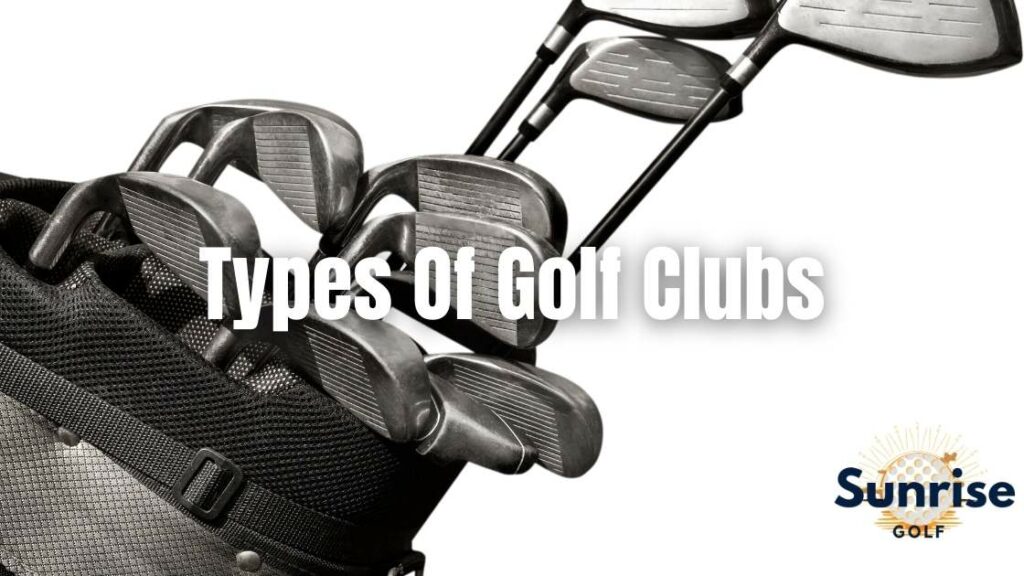You love the freedom of the fairway, the feeling of the wind in your hair as you swing. But to truly master the game, you need to know the various types of golf clubs available to play with.
From the powerful and precise Driver to the versatile Wedges, each club has its own purpose and potential.
The Driver
If you’re looking to improve your golf game, the driver is an essential club to have in your bag. The driver, also known as the 1-wood, is designed for maximum distance off the tee. Its importance lies in its ability to hit the ball the farthest and set up the rest of your shots.
One key factor to consider when choosing a driver is the loft. The loft refers to the angle of the clubface, which affects the trajectory and distance of your shots. The general rule is that the higher the loft, the higher the ball flight and the shorter the distance. Conversely, lower lofted drivers produce a lower ball flight with more roll. Finding the right loft for your swing speed and launch conditions is crucial for maximizing distance with the driver.
To maximize distance with the driver, there are several techniques you can employ. First, make sure to tee the ball at the right height. The optimal height is when the middle of the ball is level with the top of the driver clubface. This allows for a clean strike and maximum distance.
Additionally, focus on generating clubhead speed through a proper swing sequence. This includes a full shoulder turn, a smooth transition from the backswing to the downswing, and a powerful release of the clubhead through impact. Lastly, maintaining good balance and staying relaxed throughout the swing will help you generate more power and distance.
Fairway Woods
When choosing fairway woods for your golf bag, consider the versatility and distance they can provide on the course. Fairway woods are designed to hit the ball off the fairway, rough, or tee, making them a crucial part of your golf equipment. With advancements in fairway wood technology, manufacturers have developed clubs that are more forgiving and deliver greater distance.
One of the key features of fairway woods is the size of their clubheads. They tend to have larger clubheads compared to irons, allowing for a larger sweet spot and more forgiveness on off-center hits. This means that even if you don’t hit the ball perfectly, you can still achieve a decent shot.
Fairway wood swing techniques are slightly different from those used with irons or drivers. Due to their longer shafts and lower loft angles, fairway woods require a more sweeping motion to generate power and launch the ball into the air. It’s important to have a smooth and controlled swing, focusing on maintaining balance and tempo throughout the swing.
When selecting fairway woods, consider the loft angle and the material used in the clubhead. The loft angle will determine the trajectory of your shots, while the material can affect the club’s feel and performance. Additionally, try out different fairway woods to find the one that suits your swing and provides the optimal combination of distance and accuracy.
With the right fairway woods in your bag and proper swing techniques, you’ll have the freedom to attack the course from various lies and distances. So, choose wisely and enjoy the versatility and distance that fairway woods can offer.
Irons
To improve your golf game, consider adding irons to your bag, as they’re essential for various shots on the course. Irons are designed to give you precision and control, allowing you to hit accurate shots from the fairway, rough, or even from challenging lies. There are different types of iron clubs, each with its own characteristics and purposes.
The most common types of iron clubs are numbered from 1 to 9, with lower numbers representing the longer irons and higher numbers representing the shorter irons. The longer irons, such as the 1-4 irons, have less loft and are designed for longer shots, while the shorter irons, like the 7-9 irons, have more loft and are used for shorter approach shots.
One advantage of using irons in golf is their versatility. They can be used for a wide range of shots, from long drives to precise shots around the green. Irons also provide better accuracy and control compared to other clubs, making it easier to shape your shots and hit the ball with consistency.
Another advantage of using irons is their ability to generate more backspin. This backspin helps the ball stop quickly on the green, allowing you to hit approach shots that are more likely to hold the putting surface.
Wedges
You’ll find that wedges are an essential part of your golf club collection. These clubs are designed to help you make precise shots around the green and get the ball close to the hole. There are different types of wedges that you can add to your arsenal to improve your short game.
The first type of wedge is the pitching wedge, which has a loft between 44 and 48 degrees. This club is great for shots that require a high trajectory and a soft landing. It’s commonly used for approach shots from the fairway.
Another type of wedge is the sand wedge, which has a loft between 54 and 58 degrees. This club is specifically designed to help you get out of bunkers. It has a wider sole and bounce to prevent the club from digging into the sand.
Finally, there’s the lob wedge, which has a loft between 59 and 64 degrees. This club is perfect for shots that require a high trajectory and a short carry distance. It’s often used for shots around the green where you need to stop the ball quickly.
When using wedges, it’s important to have the proper technique. Keep your hands ahead of the ball, open the clubface slightly, and make a controlled, smooth swing. Practice different shots with your wedges to develop a feel for how the ball reacts.
Having a variety of wedges in your golf bag will give you more options and help you improve your scoring. So go ahead and add these essential clubs to your collection and master the proper technique for using them. Your short game will thank you.
Putters
As you search for the perfect putter, keep in mind the importance of finding one that suits your stroke and provides the right feel on the greens. Different styles of putters cater to different putting techniques and preferences.
Here are four key factors to consider when choosing the right putter:
Blade Putters: These classic putters are characterized by a thin, flat clubhead. They offer a traditional look and feel, providing a clean and precise stroke. Blade putters are favored by golfers who prefer a traditional style and have a consistent putting stroke.
Mallet Putters: These putters feature a larger, more forgiving clubhead with various shapes and designs. Mallet putters often have additional weight distributed to the perimeter, enhancing stability and reducing twisting on off-center hits. They’re popular among golfers who seek added forgiveness and alignment aids.
Related: Mallet Vs Blade Putter, Which Is Best For You?Face Balanced Putters: These putters have a balanced clubhead, meaning the face naturally points upward when the shaft is balanced on your finger. Face balanced putters are ideal for golfers with a straight back and straight through putting stroke, providing a more stable and consistent roll.
Choosing the Right Putter Grip: The grip on your putter plays a significant role in your ability to control the club. Grips come in various sizes, shapes, and textures, allowing you to find one that feels comfortable and promotes a secure hold. Experiment with different grips to find the one that suits your hand size and grip preference, ultimately enhancing your feel and control on the greens.
Conclusion
So there you have it, a comprehensive overview of the various types of golf clubs.
From the powerful Driver that can launch the ball into the stratosphere, to the versatile Fairway Woods that allow for accurate shots from a distance, to the precise Irons that offer control and accuracy, to the trusty Wedges that excel in short game situations, and finally, the reliable Putters that help you sink those crucial putts.
With this knowledge, you’ll be well-equipped to navigate the golf course with confidence and finesse.

